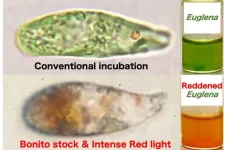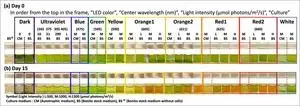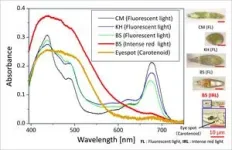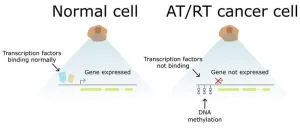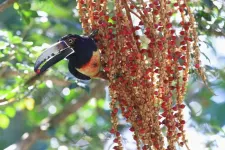(Press-News.org)
Over the past few years, people have generally become more conscious about the food they consume. Thanks to easier access to information as well as public health campaigns and media coverage, people are more aware of how nutrition ties in with both health benefits and chronic diseases. As a result, there is an ongoing cultural shift in most countries, with people prioritizing eating healthily. In turn, the demand for healthier food options and nutritional supplements is steadily growing.
In line with these changes, Assistant Professor Kyohei Yamashita from Tokyo University of Science (TUS), Japan, has been studying a promising “superfood” called Euglena gracilis for over half a decade. A species of edible microalgae, E. gracilis has a rich nutritional profile, with a unique combination of vitamins, fibers, lipids, and proteins. Like most other photosynthetic plants, E. gracilis also contains carotenoids—natural substances with a wide variety of health benefits.
In a study published in 2023, a research team from TUS found a simple method to efficiently grow E. gracilis in an inexpensive medium (solid or liquid that contains nutrients and is used to grow bacteria) based on tomato juice. Now, in a new study, the researchers have explored a promising technique to make cultured E. gracilis produce carotenoids at a higher rate, rendering it even more nutritious. This study, which was co-authored by Dr. Kengo Suzuki from Euglena Co., Ltd., as well as Professor Tatsuya Tomo and Professor Eiji Tokunaga from TUS, was published in Volume 13, Issue 4 of the journal Plants in February 12, 2024.
The proposed approach is quite straightforward, and so is its rationale. When a plant is exposed to high-intensity light for extended periods of time, it undergoes a light-stress response. This, in turn, can cause the organism to produce molecules that protect it from further light exposure, including carotenoids. Based on these facts, the researchers investigated whether they could induce such a reaction in E. gracilis to enhance its carotenoid content ratio.
To this end, the team ran a series of experiments on multiple batches of cultured E. gracilis. They exposed cultures to light of different wavelengths (or colors) and at different intensities looking for a “reddening reaction,” which is a tell-tale sign of higher carotenoid production in many plant species. Moreover, they also tested a new culture medium based on bonito stock, a soup stock extracted from Katsuobushi, a traditional Japanese dish made from smoked bonito fish.
Interestingly, the researchers found that strong red-light irradiation at 605–660 nm triggered a reddening reaction in E. gracilis when cultured in bonito stock. They also looked at the chemical profiles of the cultures using high-performance liquid chromatography, both at the culture and single-cell level. These analyses revealed that reddened cells not only had a high concentration of diadinoxanthin, the most abundant carotenoid in E. gracilis, but also produced an unidentified xanthophyll-type carotenoid. On top of these, the team also noted that bonito stock cultures grew quicker and reached higher densities than cultures grown on conventional media, and likely produced more types or amounts of carotenoids.
Together, the results of this study could pave the way for an innovative and easily scalable technique for growing nutritious E. gracilis. The method’s simplicity is certainly one of its strengths, as Dr. Yamashita remarks, “Our approach does not involve genetic modifications and could thus be readily adopted by the food industry to expand the use of E. gracilis, both in food and as a nutritional supplement.” Notably, bonito stock is a nutritious food and using it in the culture medium would, therefore, provide additional health benefits.
Aside from its benefits to us humans, growing E. gracilis can also help the environment. “E. gracilis cultivation, which requires relatively few resources, can be a sustainable food resource,” explains Dr. Yamashita. “Our research marks an important step toward the development of new food technologies that contribute to people's lives from both health and environmental perspectives.”
With the carotenoid market poised to become a multi-billion-dollar industry by 2030, this study will help deepen our understanding of carotenoid biosynthetic pathways, hopefully leading to the development of sustainable practices in the production of nutritional supplements and emerging foods.
****
Reference
DOI: https://doi.org/10.3390/plants13040510
Authors: Kyohei Yamashita1, Ryusei Hanaki2, Ayaka Mori1, Kengo Suzuki3, Tatsuya Tomo2, and Eiji Tokunaga1
Affiliations:
1Department of Physics, Faculty of Science Division I, Tokyo University of Science
2Graduate School of Science, Tokyo University of Science
3Euglena Co., Ltd.
Funding information
This research was supported by JSPS KAKENHI grant No. 21K06101.
END
A new study conducted by researchers at Tampere University and Tampere University Hospital revealed how aberrant epigenetic regulation contributes to the development of atypical teratoid/rhabdoid (AT/RT) tumours, which are aggressive brain tumours that mainly affect young children. There is an urgent need for more research in this area as current treatment options are ineffective against these highly malignant tumours.
Most tumours take a long time to develop as harmful mutations gradually accumulate in cells’ DNA over time. AT/RT tumours are a rare exception, ...
700 million years ago, a remarkable creature emerged for the first time. Though it may not have been much to look at by today’s standards, the animal had a front and a back, a top and a bottom. This was a groundbreaking adaptation at the time, and one which laid down the basic body plan which most complex animals, including humans, would eventually inherit.
The inconspicuous animal resided in the ancient seas of Earth, likely crawling along the seafloor. This was the last common ancestor of bilaterians, ...
Embargo: This journal article is under embargo until April 15 at 10 a.m. BST/London (5 a.m. EDT/3 a.m. MDT). Media may conduct interviews around the findings in advance of that date, but the information may not be published, broadcast, or posted online until after the release window. Journalists are permitted to show papers to independent specialists under embargo conditions, solely for the purpose of commenting on the work described
University researchers have shown that a transition to green wastewater-treatment approaches in the U.S. that leverages the potential of carbon-financing could save a staggering $15.6 billion and just under 30 million tonnes of CO2-equivalent emissions ...
Important differences in how the nasal cells of young and elderly people respond to the SARS-CoV-2 virus, could explain why children typically experience milder COVID-19 symptoms, finds a new study led by researchers at UCL and the Wellcome Sanger Institute.
The study, published in Nature Microbiology, focused on the early effects of SARS-CoV-2 infection on the cells first targeted by the viruses, the human nasal epithelial cells (NECs).
These cells were donated from healthy participants from Great Ormond Street Hospital (GOSH), University College London Hospital (UCLH) and the Royal ...
New research from the Crowther Lab at ETH Zurich illustrates a critical barrier to natural regeneration of tropical forests. Their models – from ground-based data gathered in the Atlantic Forest of Brazil - show that when wild tropical birds move freely across forest landscapes, they can increase the carbon storage of regenerating tropical forests by up to 38 percent.
Birds seed carbon potential
Fruit eating birds such as the Red-Legged Honeycreeper, Palm Tanager, or the Rufous-Bellied Thrush play a vital role in forest ecosystems by consuming, excreting, and ...
BUFFALO, N.Y. — The key to growing coffee plants that can better resist climate change in the decades to come may lie in the ancient past.
Researchers co-led by the University at Buffalo have created what they say is the highest quality reference genome to date of the world’s most popular coffee species, Arabica, unearthing secrets about its lineage that span millennia and continents.
Their findings, published today in Nature Genetics, suggest that Coffea arabica developed more than 600,000 years ago in the forests of Ethiopia ...
How muscle changes with ageing, and tries to fight its effects, is now better understood at the cellular and molecular level with the first comprehensive atlas of ageing muscles in humans.
Researchers from the Wellcome Sanger Institute and their collaborators at Sun Yat-sen University, China applied single-cell technologies and advanced imaging to analyse human skeletal muscle samples from 17 individuals across the adult lifespan. By comparing the results, they shed new light on the many complex processes underlying age-related muscle changes.
The atlas, published ...
A new study led by the Barcelona Institute for Global Health (ISGlobal), a centre supported by the "la Caixa" Foundation, sheds light on the growth of lung function in children. The results show that increased levels of physical activity and a higher body mass index (BMI) play a key role in the recovery of early deficits. These findings, published in the journal Thorax, have important implications for clinical practice, research and public health policy, providing new insights into how to improve respiratory health from childhood to adulthood.
The study analysed data from the ...
Modern websites place ever greater demands on the computing power of computers. For this reason, web browsers have also had access to the computing capacities of the graphics card (Graphics Processing Unit or GPU) in addition to the CPU of a computer for a number of years. The scripting language JavaScript can utilise the resources of the GPU via programming interfaces such as WebGL and the new WebGPU standard. However, this harbours risks. Using a website with malicious JavaScript, researchers from the Institute of Applied Information Processing and Communications at Graz University of Technology (TU Graz) were able to spy on information about data, keystrokes and encryption ...
Key Takeaways
Results from a new study indicate that physical activity may help protect against cardiovascular disease in part by reducing stress-related brain activity
This effect in the brain may help to explain why study participants with depression (a stress-related condition) experienced the greatest cardiovascular benefits from physical activity.
BOSTON – New research indicates that physical activity lowers cardiovascular disease risk in part by reducing stress-related signaling in the brain.
In the study, which was led by investigators at Massachusetts General Hospital (MGH), a founding member of the Mass General Brigham healthcare ...
